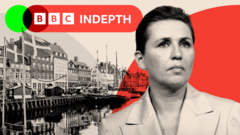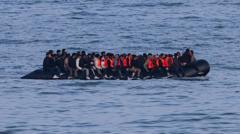Denmark has emerged as a leader in strict immigration policies, driven by its center-left government. While many European nations grapple with migration, the Danish approach highlights a deeper societal shift, showcasing the complexities of political ideologies and public sentiment regarding immigration.
Denmark's Surprising Shift: Left-Wing Politicians Driving Strict Immigration Policies

Denmark's Surprising Shift: Left-Wing Politicians Driving Strict Immigration Policies
In a notable reversal of expectations, Denmark's center-left government has implemented tough immigration measures, traditionally associated with far-right politics.
Denmark, often imagined as a model of liberalism and openness, has recently garnered attention for its stringent immigration measures. Marie Sandberg, Director of the Centre for Advanced Migration Studies at the University of Copenhagen, asserts that Denmark has become "a pioneer in restrictive migration policies" within Europe, particularly concerning both asylum-seekers and economic migrants.
Counter to the assumption that far-right factions are primarily responsible for tightening immigration laws, Denmark stands out with its center-left politicians leading the charge. Similarly, Spain, which represents a markedly different approach by increasing immigration, becomes pertinent in this discussion.
Migration has escalated as a pivotal issue across Europe, especially amidst geopolitical tensions, economic instability, and a rising cost of living. While Denmark has seen a significant uptick in the immigrant population since the post-World War II era, its turning point came during the 2015 European migration crisis when the influx surged.
Slogans like "Danskerne Først" (Danes First) resonated among voters, indicating a growing apprehension about the perceived challenges of migration. Denmark's stringent measures included the controversial policy allowing authorities to seize valuables from asylum seekers to cover the costs of their stay. This focus led to numerous tightening amendments under the leadership of Danish immigration authorities.
As economic and welfare concerns took center stage, the Social Democrats, under Mette Frederiksen, redefined their position on immigration. Rather than maintaining their reputation as proponents of inclusivity, the party absorbed policies traditionally associated with the far right, presenting a narrative that prioritizes Danish welfare.
Critics argue that the shift represents a cynical ploy to secure political power. However, Frederiksen insists her party's stance mirrors a genuine concern for social cohesion and public services, crucial to maintaining support among Dane voters. The economic implications of demographic changes necessitate a delicate balancing act between preserving social structures and addressing the needs of the population.
Denmark's increasing isolationist stance on immigration echoes across Europe, where political entities across the left-right spectrum are recalibrating their narratives surrounding migration to retain electoral support. This blurring of political identities raises questions about the future of migration discussions in the broader European context.
While asylum applications in Denmark have reached a 40-year low, the country’s geographical position offers a sense of relative security compared to nations like Italy. Observers note that accusations of creating a “hostile environment” may have far-reaching implications, resulting in a nation increasingly identified with exclusionary measures.
In stark contrast, Spain’s Socialist Prime Minister, Pedro Sanchez, is advocating for legalizing nearly a million undocumented migrants, underscoring a commitment to maintaining economic growth and tackling labor shortages. The Spanish model highlights an increasing recognition of the benefits of managed migration, even in the face of growing anti-immigrant sentiments.
Ultimately, the question of which immigration model bears the most success is deeply subjective, shaped by political priorities, economic needs, and humanitarian ideals. As Denmark charts a course distinct from its Nordic neighbors, it becomes apparent that the conversation around immigration is evolving, and the established principles of the past are now subject to scrutiny.
In this reshaped landscape, a one-size-fits-all migration plan seems elusive. Voter sentiments often showcase a desire for nuance, seeking a compromise between protective measures and equitable policies for migrants. As each nation grapples with its unique challenges, the critical dialogue surrounding migration policy continues to unfold.






















